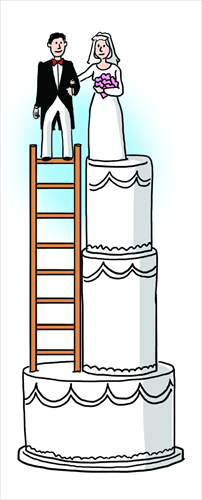By Tilak Jha

Illustration: Liu Rui/GT
Caste remains a major obstacle in creating an egalitarian India. But that might change a couple of decades from now, as more and more marriages end up being inter-caste. Inter-caste marriages challenge the core of the caste hierarchy, since the taboo against marrying the "wrong" caste was one of the most traditionally powerful.
Kumudini Das and others, in a 2010 paper based on extensive National Family Health Survey data, revealed that about 11 percent of total marriages in India are now inter-caste though large variations remain across caste and region. One prime reason behind such marriages is that as more people marry late, they tend to go caste neutral.
The tendency for inter-caste marriage is highest among the "scheduled castes," traditionally disadvantaged groups. Regionally, in the western and southern states of India where education and development is high, inter-caste marriages are more acceptable.
Punjab, with its entrepreneurial and adventurous Sikh community, whose faith has often been opposed to the caste system, beats the general north Indian conservative trend.
Similarly, the southern state of Kerala, which has the highest literacy rate in India, at 95.5 percent, has one of the highest proportions of inter-caste marriages at around 20 percent.
Market forces are contributing as well. Since the economic turnaround began in India, urbanization and strong monetization of many caste professions like that of goldsmiths has made caste specific rights or occupation irrelevant. They also matter more than ever in socioeconomic and political matters.
Money also comes into play for the poor, since the central and many state governments actively promote inter-caste marriages and even offer substantial financial assistance. The reservation of seats for disadvantaged low-caste people in education, jobs and elected bodies has only made it more likely that men and women of various castes get to know each other better.
But not all share the optimism around inter-caste marriage. Yagati Chinna Rao, a professor in New Delhi, says that even today, caste-related exclusion in India is embedded in societal interrelations and institutions. The few and far inter-caste marriages mostly take place in urban settings and do not challenge the caste system per se.
Such marriages are conveniences and end up being part of the caste system with sociocultural adjustments rather than being forms of rebellion.
The private sector led market is not fair either. Most poor-paying jobs are done by low caste. They are also less likely to get white-collar jobs. That discrimination, covert and overt, remains a norm that is evident from everyday headline of caste related reprimands, beatings, and even killings and arson.
But neither democracy nor modernity may eliminate traditional social caste structures by themselves. Caste groups have simply used modernity to achieve sociocultural parity and democracy to counter their political and economic alienation.
Caste-based mobilization remains a strong feature of the emerging socio-politico-economic institutions and equations, even as they increasingly emulate the existing ones dominated by upper caste and are becoming inclusive.
There is also an undercurrent of Sanskritization, the adoption of Brahminical beliefs, rituals, habits and values.
Amid the host of evolving dynamics, affirmative action through reservation has brought advantages and disadvantages inside caste groups.
Some well-to-do and powerful members of backward castes have raised political struggles to be included in categories that could get them more benefits. But a shrinking number of public jobs and an increasing number of private schools and universities make reservation increasingly irrelevant.
Meanwhile, the caste pot is kept boiling for political purpose by leaders of all parties.
After all, caste groups act as their vote bank. With increasing sociopolitical empowerment and strong laws against caste practices, caste-based discrimination and repression is on its way out. Yet, like religion, caste might remain tied to the instincts of most Indians for many more years.
The author is a doctoral researcher on Chinese media at the Centre for East Asian Studies, School of International Studies, Jawaharlal Nehru University, New Delhi. tilakjha@gmail.com
No comments:
Post a Comment
Please let us know your comments!